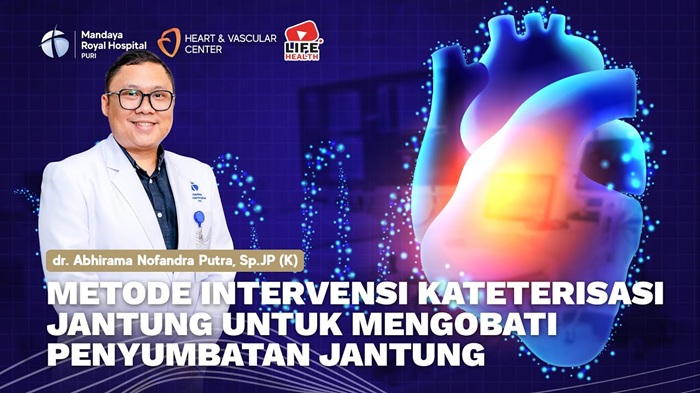Heart blockage, also known as coronary artery disease, is one of the leading causes of heart attacks. It occurs when plaque builds up along the artery walls, restricting blood flow to the heart muscle. When blood flow is limited, the heart lacks sufficient oxygen, causing symptoms such as chest pain, shortness of breath, and fatigue.
One of the most common methods to treat heart blockage is cardiac catheterization, or Percutaneous Coronary Intervention (PCI). This minimally invasive procedure allows cardiologists to identify and treat blockages in the coronary arteries.
At Mandaya Royal Hospital Puri, this procedure is performed by experienced cardiologists, including dr. Abhirama Nofandra Putra, Sp.JP (K), who specializes in minimally invasive cardiac interventions for coronary artery disease.
Contents
Cardiac Catheterization Treatment Options for Heart Blockage
According to dr. Abhirama, there are several interventional techniques available to treat coronary blockages. The choice of procedure depends on the patient’s arterial anatomy, severity of blockage, and overall health condition. The following are some of the treatment options performed through cardiac catheterization:
1. Stent Placement (Coronary “Ring”)
The term “heart ring” commonly refers to a stent, a small mesh tube inserted into the artery to keep it open after balloon angioplasty. The procedure begins with the injection of contrast dye to locate the blockage. Once identified, a small balloon is inflated to open the artery, and a stent is placed to prevent it from narrowing again. Stents play a crucial role in maintaining smooth blood flow to the heart and preventing recurrent blockages.
2. Drug-Coated Balloon (DCB)
Instead of a stent, doctors may use a Drug-Coated Balloon (DCB) — a special balloon coated with medication. When inflated inside the artery, the drug is released to the vessel wall, preventing excessive cell growth that could cause restenosis (re-narrowing).
A key advantage of DCBs is that they leave no implant behind, making them ideal for certain cases where stent placement is not suitable. This option is increasingly preferred due to its effectiveness in maintaining natural vessel function.
3. Atherectomy (Plaque Modification or “Artery Drilling”)
For blockages caused by hard or calcified plaque, atherectomy may be performed to shave or break down the plaque inside the artery.
Several types of atherectomy can be used:
- Rotational Atherectomy (Rotablator): Uses a high-speed rotating burr to remove calcium buildup.
- Orbital Atherectomy: Similar to rotational, but the burr spins in an orbital motion around the vessel wall.
- Intravascular Lithotripsy (IVL): Uses shock waves to fracture calcium deposits in the artery.
This technique prepares the vessel for easier balloon expansion or stent placement.
According to dr. Abhirama, these methods complement each other, and the best choice depends on each patient’s specific condition.
4. Intravascular Imaging and Physiological Assessment
In addition to treatment, interventional cardiologists often use intravascular imaging technologies like IVUS (Intravascular Ultrasound) and OCT (Optical Coherence Tomography) for detailed visualization of the arteries.
Physiological assessments such as FFR (Fractional Flow Reserve) help evaluate how much a blockage affects blood flow.
These technologies enable cardiologists to plan the most effective therapy and minimize complications.
Does Every Heart Blockage Require a Stent?
dr. Abhirama emphasizes that not every heart blockage immediately requires a stent or catheterization procedure. A thorough cardiac assessment is essential to determine the most appropriate therapy.
If you experience symptoms such as chest pain, shortness of breath, or frequent fatigue, consult a cardiologist as soon as possible. Early detection and treatment can prevent serious complications and help maintain long-term heart health.
Profile and Consultation Schedule of dr. Abhirama at Mandaya Royal Hospital Puri

dr. Abhirama Nofandra Putra, Sp.JP (K) is a cardiologist specializing in interventional cardiology, focusing on cardiac catheterization to diagnose and treat coronary artery disease.
He is known for his meticulous, careful, and technology-based approach in treating various cardiac conditions, including artery narrowing and blockage.
dr. Abhirama earned his Medical Doctor degree from the Faculty of Medicine, Universitas Indonesia (2011) and completed his Cardiology Specialist training at the National Cardiovascular Center Harapan Kita, Faculty of Medicine Universitas Indonesia (2019).
He later advanced his training as an Interventional Cardiologist at Renji Hospital, Shanghai Jiaotong University School of Medicine — one of Asia’s leading cardiovascular centers — in 2025.
As an interventional cardiologist, dr. Abhirama has extensive experience performing diagnostic and therapeutic minimally invasive cardiac procedures, including:
- Pericardiocentesis
- Temporary Pacemaker
- Cardiac Puncture
- Coronary Angiography
- Cath Lab Procedures
- Cardiac Electrophysiology
- Electrocardiogram (ECG)
- Cardioversion
- Cardiac Catheterization
- Stent Placement (Coronary Ring)
- Comprehensive Cardiac Consultation
- Stress Test (Treadmill Test)
Consultation Schedule
You can meet dr. Abhirama Nofandra Putra, Sp.JP (K) at Mandaya Royal Hospital Puri during the following hours:
- Monday – Friday: 09.00 – 15.30 WIB
- Saturday: 13.00 – 15.00 WIB
To make your visit easier, you can schedule an appointment with dr. Abhirama through the Chat via WhatsApp, Book Appointment feature, or the Care Dokter app, available on Google Play and the App Store, to check queue numbers and access complete visit information conveniently.



